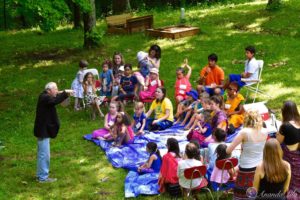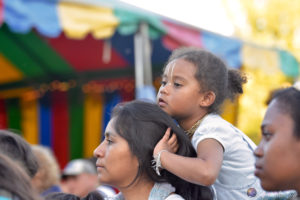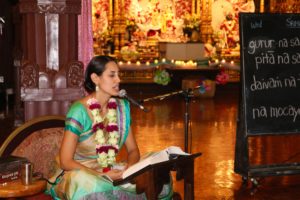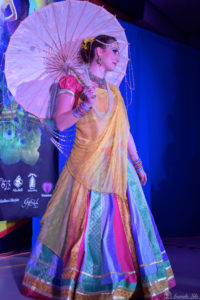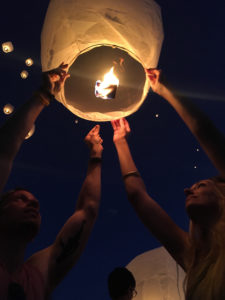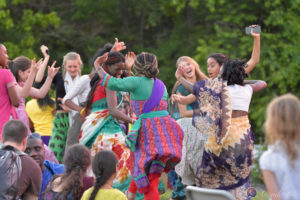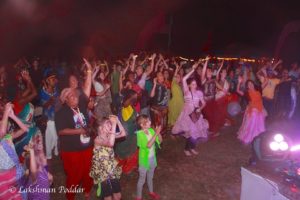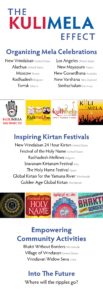Kulimela 2016: The Next Generation – March/April 2017 BTG
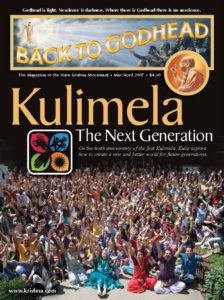
Kulimela 2016 group photo featured on the front cover of the March/April 2017 issue of Back to Godhead magazine.
Kulimela: The Next Generation
Back to Godhead March/April 2017
By Madhava Smullen
On the tenth anniversary of the first Kulimela, Kulis explore how to create a new and better world for future generations.
In a leafy yard in New Vrindaban, West Virginia, a large group of children is leaning forward, riveted, as award-winning storyteller Sankirtana Dasa does what he does best.
“Please help me!” he squeaks, impersonating the mouse in one of Srila Prabhupada’s favorite parables. Then he cycles through an impressive library of animal noises, as a sage turns the mouse into predator after predator so he’ll no longer be prey.
The kids are on the edge of their seats. Who will he turn into next? Finally, Sankirtana mimics a ferocious tiger and tries to eat the sage, who promptly orders, “Again become a mouse!” And the children all fall about in helpless laughter.
Over the four days of Kulimela’s tenth anniversary festival, from June 15 to 19, 2016, Vraja Johnson and her volunteers care for nearly a hundred children of gurukulis in this kids’ camp. They visit Prabhupada’s Palace, get unique Jagannatha deities made by a balloon artist, do arts and crafts, and model outfits they’ve made themselves in their own fashion show.
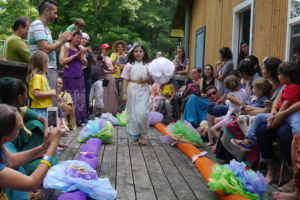
A kids’ camp participant models her fun fashion statement for fellow campers and their parents, her creation designed during a craft activity.
Meanwhile teenagers, some of them also the children of “kulis,” are staffing the Mela’s jam-packed all-day Bhajan Kutir. Beaming from ear to ear, roaring out the holy names, and completely absorbed, they clearly wouldn’t want to be anywhere else.
Even the youngest kids are engaged. On the first day of the Mela, I sit with my two-year-old, Ambika, in the temple as other kulis do bhajanas. She rocks back and forth eagerly on my lap, grooving to the mantra with a huge grin on her face, until the leader stops. “Noooo!” she cries, throwing a fit until they start up again, and then she’s back to grinning and rocking.
“Back in 2006 at the first Mela, few of us organizers had kids,” says Govinda Syer, a charter member of the nonprofit behind the festival. “Now, each of us has at least one. That completely changes how we think about the event. Because now we’re thinking, how does each element work with children? How do we give them a good experience?”
Kulis who attended ISKCON’s early gurukulas, or boarding schools, did of course have some good experiences. But they also suffered from the mistakes and abuse of an immature educational system and staff. So today, they’re determined to give their own children a more positive experience of Krishna consciousness.
And that’s what lead organizer Bhima Walker is focusing on at Kulimela 2016. Sometimes it’s through making sure the next generation has a good time at the festival. And sometimes, it’s through discussing the Mela’s two main themes – Celebrating Family and Building Community – in seminars that may just help shape the future of ISKCON.
Investing in Our Future
By lunchtime on Wednesday, June 15, participants are lining up on the temple grounds to register and get their wristbands and t-shirts, tightly embracing old friends in emotional reunions, and getting excited about what’s to come.
Throughout the Mela around seven hundred kulis from North America, South America, Europe, and Australia will participate, as well as their children, and many first generation devotees too – all part of organizers’ efforts to bridge divides and broaden the meaning of the word “kuli” to its literal definition of “community.”
What’s more, the second generation attendees themselves are no longer just “youth,” as kulis are still often known throughout ISKCON. An erroneous and dated perception, it minimizes what they’re able to contribute. The kulis here range from their teens to their late forties, and many are working professionals – I chat to an Ernst & Young manager, an Android app developer, and an X-ray tech – as well as active contributors to their communities and, of course, parents.
These passions come out in the Mela’s two central plenary sessions. As a parent and a kuli myself, I’m hoping for some inspiration as I walk into a packed and buzzing community hall on Thursday for the first of these, “Celebrating Family.” And I’m not shortchanged.
Presentations by a mixed panel of first- and second-generation experts in their fields lead to a lively discussion with the audience and rousing calls to action.
There’s a consensus that focusing on healthy marriages and happy families will make for a stronger ISKCON. Kulis are encouraged to invest in the future by teaming together on projects that positively affect children in their local communities. They also discuss making lots of small specialized groups in their communities to encourage members’ interests and make them feel like they belong.
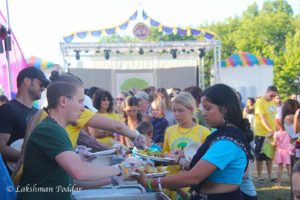
Delicious dinner prasadam prepared by a skilled kitchen crew led by Radha Dainton and Nityananda Prins is served out to a hungry crowd.
The conversation is always empowering. “We are the community, we are the temple, we are ISKCON,” says audience member Syamasundari Dasi from Alachua. “So if something needs to be done, we must step up and do it ourselves.”
And Chaitanya Mangala Dasa, one of Kulimela’s organizers, points out what a practical difference these efforts can make.
“I met Bhakta Vatsala Prabhu’s teenage son Kapila Baba today,” he shares. “Kapila had been in the kids’ camp I organized at the first Kulimela in 2006. He said, ‘I don’t know if you remember me, but I want you to know I had a great time.’ Now, he’s blissfully chanting at the Bhajan Kutir, and enthusiastically serving on the Festival of India tour.” Chaitanya Mangala’s voice cracks, and he fights back tears. “Who knows where he’s going to go from here?”
“Building Community,” the other main plenary session of the Mela, is no less inspiring. Pioneer kulis marvel at how far our community has come, and how wonderful it is to see the younger generations coming up. They also implore everyone to bridge the designations that divide us.
Others give practical reports on their community-building efforts. Gopinath Bloch talks about the Sanga Initiative, which keeps North American youth connected and active in Krishna consciousness. And Gopi Gita Dasi gives an enlivening report from Dallas, once infamous for the abuse early gurukula students suffered there. Today, its kuli-run TKG Academy dayschool has forty students, who are getting a fun, positive experience of Krishna consciousness that focuses on the dos rather than the don’ts, and who are in the top ninetieth percentile for academics in the state of Texas.
Beyond the two plenary sessions, festival goers further arm themselves to make a difference with the Mela’s nearly thirty seminars on parenting, homsechooling, child protection, finding the right marriage partner, permaculture, and arts like cooking, music, and drama. With multiple seminars taking place side by side, there’s a palpable uplifting energy as kulis buzz from class to class, laughing and chatting about what they’ve learned.
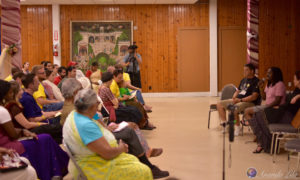
Pioneer Kulis Ananta Vrndavana Dasa (with microphone) and Karnamrita Dasi (to his left) are honored at a group appreciation led by Chaitanya Mangala Dasa (to Ananta Vrndavana’s right).
One of the most popular sessions is on Friday, when Karnamrita Dasi and Ananta Vrindavana Dasa, both alumni of Dallas and New Vrindaban gurukulas, are honored for their unique contributions and sacrifices as pioneer kulis. As they share memories of good times and challenges, there’s uproarious laughter and tears, with not a dry eye left in the house.
The appreciation ceremony is a feature that organizers want to continue at every Kulimela, inspired by Srila Prabhupada’s statement in a Nectar of Instruction purport that “The International Society for Krishna Consciousness has been established to facilitate these six kinds of loving exchanges between devotees.” The hope is that the devotee appreciation will continue between Melas, too.
Unity Through Krishna Culture
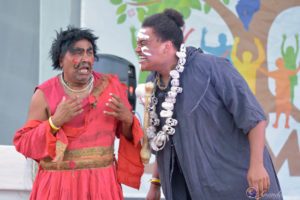
The Bhaktivedanta Players, from the UK, perform “Sanatana Gosvami and the Touchstone.” (Jaya Krsna Dasa on left, Radhe Sivyer on right.)
Dusk has fallen. Kulis are crowded onto a green New Vrindaban hill, on an open end of the lush Community Garden, for a different kind of appreciation event. Bass is pounding and multicolored lights are flashing on a huge stage topped with Lord Jagannatha’s smiling face. A hyped-up audience is dancing in sync, fists pumping to the funky reggaeton beats.
On the stage Arjuna Moreira, aka Krishna Tone, shouts, “Who we thinkin’ of?” and the crowd roars back in one voice, “Krishna!!!”
Kulimela might look like a regular music festival, but there’s a difference: both performers and audience are constantly expressing their love for the Lord.
This Kulimela has one marked difference from the first one in 2006, too: the family atmosphere. The adults are having fun, but there are also special stageside tents for children who need to take a nap. And best of all, Krishna Tone has invited a huge crowd of young kids onstage to dance with him. They strike Radha and Krishna poses, do cartwheels, and take bows, looking hugely pleased with themselves and delighting their parents’ hearts.
This mood of supportive community stretches out to every part of the nightly entertainment. As always, Kulimela champions new talent, like fifteen-year-old Pishima Calloway from Gita Nagari, who blows everyone away with her huge voice. Singing soulful lyrics like “He is my savior, my everything, I sing for Him,” she hits high notes that elicit a spontaneous roar of applause from the crowd.
The seasoned performers dazzle too – Ananda Monet with her operatic Mahabharata songs, Anapayini Jakupko and Ganga Sheth with their evocative dance, and Dattatreya Yogeshvara Dasa with his magic – all thrill and touch hearts.
Meanwhile with her runway show “Forest of Vrindavana: Fashion Revolution,” Krishna Devata McComb showcases the new world of kuli designers. They display incredible handloomed dhotis and kurtas, outfits inspired by the Rajasthani tribeswomen of India, and gopi dresses with elaborate accessories like beaded umbrellas and decorated waterpots. The show also honors its theme by donating wool shawls to the widows of Vrindavan, India, and funds to New Vrindaban’s cow protection program.
The grand finale comes with fifty lanterns being released into the night sky for fifty years of ISKCON, sent off with individual and group prayers. As the golden splashes of fire float above the crowds, the Mayapuris burst onstage with their unique brand of rocking kirtana.
“How many of you had a Quaker Oats oatmeal box for your first mridanga?” Visvambhar Sheth asks as the amplified mridanga thunders into earshot. Kulis go wild, moshing, spinning, and busting their best temple dance moves to songs like “Jai Sri Krishna” and “Sita Rama.” Holding his “whompers” to his ears, hype man Krishna Kishora Dasa invites everyone to chant louder and louder.

Festival participants releasing fifty sky lanterns at twilight (above), accompanied by chanting and prayers from the main stage, to celebrate and commemorate ISKCON’s fiftieth and Kulimela’s tenth anniversaries.
As the blistering set reaches its conclusion, and everyone is left grinning, panting, and sweating, Balarama Tirtha Dasa leaves us with a heartwarming thought: “We may all be such varied people spread across all corners of the world,” he calls out. “But we all have one thing in common: we love Krishna, and we love Srila Prabhupada!”
This intrinsic unity in kulis, and the stunning cultural talent on display, recalls a letter Prabhupada sent to Syamasundara Dasa when his daughter Sarasvati was two. “I am very glad to learn about the activities of your nice daughter,” he wrote. “I am sure she will be a great devotee and great preacher also in future. I want that on this Krishna culture the whole world can be united.”
Service for the Soul
There’s much to remember about Kulimela 2016 – the seminars, the performers, the ecstatic 24-hour kirtana closer. But perhaps most defining of all is the service – as organizer Kapila Monet comments, “A vital aspect of kuli culture is service, and that’s what we want it to be all about.”
Over the five days, hundreds of volunteers cook delicious prasadam meals, wash mountains of dishes, battle through weather challenges and lack of sleep to organize the entertainment and seminars, practice for hours to share their talents, staff the kids’ camp, and much more.
“The people who have the best experiences in a Kulimela are the ones who experience the pleasure and fun that goes into serving others,” says organizer Baladeva Keilman. “They get to meet new people and build a personal connection with them that they remember for years to come. It’s very special and rewarding.”
Baladeva hopes that putting on festivals such as Kulimelas will inspire kulis to serve their communities more and more from their hearts.
“They’re already doing it all around the world, and that’s something to be really proud of,” he says. “Despite everything that the first generation of kulis went through, that link, that desire to serve Srila Prabhupada and Krishna, is there. And it’s becoming stronger as we share it with our children. That’s why we put such a strong focus on giving them wonderful positive experiences in relation to Krishna. Because then their link to Prabhupada’s mission will be that much stronger. As Prabhupada famously said, it will be these future generations that will take his movement forward.”
I believe him. I’m just about to take Ambika to another kirtana, and I’m warning you – if it stops, she’ll scream.
After all, she already loves Krishna – all we have to do is surround her with reasons to keep loving Him.
For more information, visit http://kulimela.org/ or https://www.facebook.com/kulimela.
What is a “Kuli”?
Gurukulis were students in ISKCON’s early spiritual boarding schools, or gurukulas. When they graduated, they remained bonded through their shared experiences and kept the moniker. The name was later shortened to “Kuli,” and broadened to include anyone who grew up in the Hare Krishna movement, even if they hadn’t attended gurukula.
Today, Kulimela organizers have further broadened the term Kuli to mean “a member of a particular family, tribe, or community,” which is closer to its literal Sanskrit meaning. This also accommodates the needs of their complex, expanding group.
Kulimela, meanwhile, means “Family Festival,” or as organizers like to say, a chance to “Celebrate Community!”
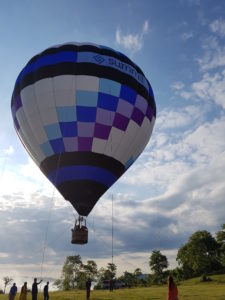
Early morning balloon rides offer festival participants a bird’s-eye view of Srila Prabhupada’s Palace and other parts of New Vrindaban.
The Kulimela Effect
The first Kulimela, held in New Vrindaban in 2006, was an attempt to bring kulis from all over the world together to support each other and explore what they could achieve.
The result – “The Kulimela Effect” – has been expanding out in waves of collaborative service ever since.
Ten follow-up Melas were held in France, Germany, Belgium, Russia, Siberia, Australia, New Zealand, and, in the U.S., Los Angeles, Alachua, and once again New Vrindaban.
Kulis were inspired to form local networks to contribute to their own communities, and many started major annual kirtana festivals: New Vrindaban’s 24-Hour Kirtan, Alachua’s Festival of the Holy Name, Belgium’s Radhadesh Mellows, Italy’s Sravanam Kirtanam Festival, and Spain’s Holy Name Festival all sprouted from Kulimela.
There were also worldwide events to raise consciousness – Global Kirtan for the Yamuna River, and Golden Age Global Kirtan. And in Alachua, Florida, Kulimela inspired second-generation devotees to build an annual “Village of Vrindavan” experience every Janmashtami at their local temple.
In addition Kulimela Association, the nonprofit behind the Melas, has backed spiritually motivated philanthropic efforts. It is the record label for the Grammy-nominated album Bhakti Without Borders, which donates all its profits to clothe, feed, and educate underprivileged girls in Vrindavan, India. It also partners with Krishna Devata to distributes saris and shawls to Vrindavana’s widows and sadhus.
Looking to the future, Kulis see that the possibilities are endless. But whatever comes next, its sure to incorporate Kulimela’s four essential themes: Building Community (Sanga), Serving Together (Seva), Empowering Each Other (Sakti), and Transforming Hearts (Bhakti).
